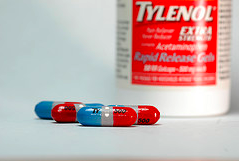Fun With Reading Labels: What Does “Extra Strength” Actually Mean?
Have you ever been in the medicine aisle and been like, “Wait, I don’t just need strength. I need more than strong! I need extra strength!” Probably not, but when faced with just a regular medication and one that touts “extra” or “maximum” strength, you’ll likely go for the one that promises to heal what ails you faster. But what do all those labels actually mean?
Our savvy siblings over at ShopSmart Magazine delve into the complicated world of labeling in the drug aisle to come up with some answers for the curious consumer. Part of the reason there’s so much confusion is because there are no set definitions for terms like “all-day formula” or “long-acting,” Carmen Catizone, the executive director of the National Association of Boards of Pharmacy tells ShopSmart.
When it comes to extra, maximum and ultra-strength, they all basically boil down to the same thing: the formula contains more of its active ingredient than the regular version. It can be confusing then, because while Extra Strength Tylenol contains 54% more acetaminophen than normal Tylenol, that doesn’t mean that Extra Strength of some other OTC product also has 54% of its active ingredient. So what does it all mean?
EXTRA STRENGTH
Examples: Extra Strength Tylenol, Alka-Seltzer Extra Strength
What it means: You’ll get get an extra dose of the active ingredient vs. the regular version. For example, Alka-Seltzer Extra Strength has 54% more of its pain-relieving ingredient; Gas-X Extra Strength has 56% more of its active ingredient.
What to watch out for: Always read labels carefully for any drug you take; products with claims like “Extra Strength” may be a lot stronger than what you’re used to. Also, be sure not to exceed the daily dosage.
MAXIMUM STRENGTH
Examples: Maximum Strength Pepcid AC, Maximum Strength Mucinex Expectorant
What it means: You’ll get more of the active ingredient than in the regular version, but you won’t necessarily get the maximum dose you can buy.
What to watch out for: Read directions about dosing carefully or there’s a chance you could overdo it. With Pamprin Max, for example, you can take two pills every 4 to 6 hours. But if you take them every 4 hours, you’ll wind up taking 12 pills in a day, when the daily maximum is set at eight pills in a 24-hour period.
ALL DAY
Examples: All Day Strong Aleve, All Day Allergy-D
What it means: The medication may last 12 hours or more. So for some meds, one daily dose is all you need. That’s because it’s an extended-release version, so it keeps working over the course of many hours.
What to watch out for: “All day” might refer to the part of the day that you’re awake or to an actual day, meaning a full 24-hour period. Read labels carefully to determine whether you need to take the drug once every 12 hours (then perhaps switch to a nighttime formula) or once every 24 hours.
DUAL ACTION
Examples: Dual Action Pepcid Complete, Ricola Dual Action
What it means: “Dual action” implies the drug is designed to relieve symptoms for two different but usually related problems. The drugs either have more than one active ingredient or an active ingredient that works to improve two symptoms.
What to watch out for: Drugs with more than one active ingredient can put you at risk of an accidental overdose if you take other meds with one of those ingredients. Or you could end up taking extra drugs you don’t need.
For more terms and their explanations, check out the October issue of ShopSmart, on stands now.
Want more consumer news? Visit our parent organization, Consumer Reports, for the latest on scams, recalls, and other consumer issues.


